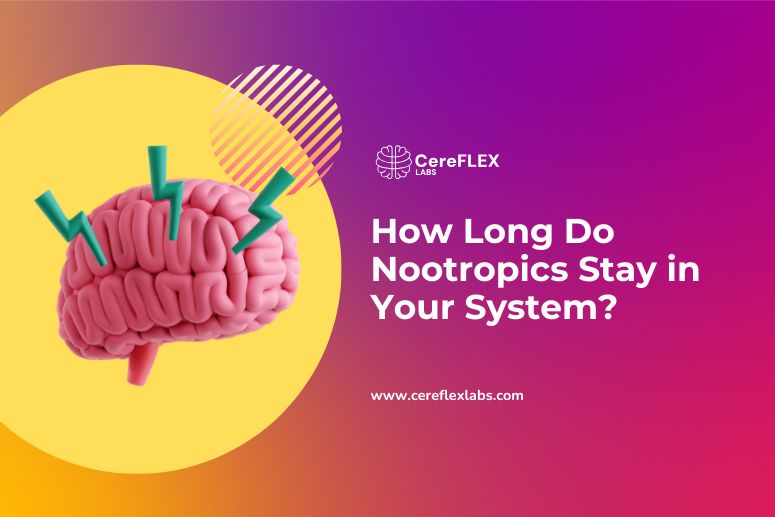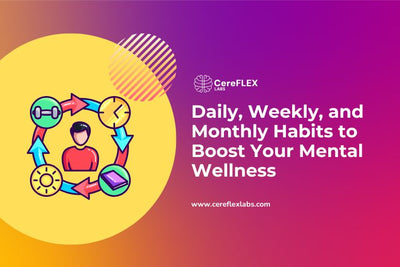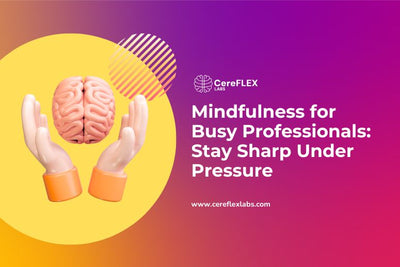Many people use nootropics—also known as cognitive enhancers—to support focus, memory, or mental energy. Whether you're a student, professional, or simply aiming to stay sharp, understanding how long these compounds stay in your body is key to using them effectively.
Some nootropics take effect within minutes and wear off by the afternoon. Others may stay active for hours—or even linger in your system into the next day.
If you’re using natural compounds like L-Theanine or more potent options like Modafinil, it's important to know how your body absorbs, processes, and eliminates them. This knowledge can help you time your intake, manage side effects, and avoid potential stacking conflicts.
Here is the Quick Answer |
|
How long nootropics stay in your system depends on several factors: the type of compound, dosage, metabolism, age, and how often it’s used. For example, caffeine has a half-life of about 5 hours, while Modafinil may last 12–15 hours. Fat-soluble nootropics can build up over time with regular use. Most nootropics aren’t detected in standard drug tests, but a few synthetic types may be. Always follow label directions and consult a healthcare provider if you're combining supplements or medications. |

Understanding Nootropics and How They Work
Nootropics are substances used to support brain function—such as focus, memory, mental clarity, or energy. People often turn to them during high-demand periods like exams, deadlines, or long workdays.
They fall into two broad categories:
1. Natural nootropics: These are derived from plants, herbs, or compounds already found in the human body. Examples include:
- L-theanine, found in green tea and traditionally used to promote calm focus
- Bacopa monnieri, an herb used in Ayurvedic medicine to support memory over time
- Alpha-GPC, a choline compound involved in supporting attention and cognitive function
2. Synthetic nootropics: These are lab-formulated substances created for more targeted or potent effects.
A common example is Modafinil, originally developed to promote wakefulness in individuals with narcolepsy. It’s now used off-label in high-performance settings to support extended mental focus.
Nootropics may influence brain performance in several ways. Depending on the compound, they may work by:
- Modulating neurotransmitters: Influencing brain chemicals like dopamine, acetylcholine, or serotonin to help support attention or mood regulation
- Improving cerebral blood flow: Enhancing oxygen and nutrient delivery to the brain
- Balancing brainwave activity: Supporting calm alertness or sharper focus through changes in alpha and beta brainwaves
- Providing neuroprotective compounds: Offering antioxidant support to help protect brain cells from oxidative stress
- Enhancing neural signalling: Supporting how efficiently brain cells communicate, which may contribute to improved mental clarity
Not every nootropic works the same way or for the same duration. That’s why understanding their mechanisms—and how your body processes them—is essential for safe and effective use.
How the Body Processes Nootropics
After you take a nootropic—whether as a capsule, powder, or drink—it begins a journey through your body. First, it enters your digestive system, then moves into the bloodstream, where it can travel to your brain and interact with neurons, neurotransmitters, and receptors.
This is when you begin to feel the effects—such as increased alertness, improved focus, or mental clarity, depending on the compound.
Once its role is complete, your body begins the process of breaking it down and clearing it out.
The liver plays a central role in metabolizing most nootropics. It transforms them into byproducts (called metabolites) that your body can more easily remove.
These metabolites are typically excreted through the kidneys in urine, though some may also be eliminated through stool or sweat.
The speed and efficiency of this process varies from person to person and depends on the specific nootropic taken—as well as individual factors like age, liver function, and metabolic rate.
Factors That Affect How Long Nootropics Stay in Your System
The amount of time a nootropic stays in your body isn’t one-size-fits-all. It depends on the compound itself and on how your body processes it.
Here are the key factors that influence duration:

Type of Nootropic
Every compound has a different half-life—the time it takes for its concentration in your blood to drop by half. For example caffeine’s half-life is around 5 hours, while that of Modafinil is between 12 and 15 hours.
Shorter half-lives mean quicker elimination. Longer half-lives extend both effects and system presence.
Dosage
Higher doses take longer to break down. A larger amount means your liver and kidneys work longer to clear the substance, which extends the time it stays active in your system.
Frequency of Use
Frequent use—especially of fat-soluble nootropics—can cause compounds to build up in your body. This accumulation may extend both the intensity and duration of effects.
Metabolism
Your metabolism plays a big role.
- Faster metabolism = quicker elimination
- Slower metabolism = prolonged effects and delayed clearance
Age
As we age, liver and kidney function often slows down. This can lengthen the time it takes for your body to process and remove certain nootropics.
Body Composition
Fat-soluble compounds may be stored in fat tissue, making them linger longer in the body—especially in those with higher body fat percentages.
In contrast, water-soluble nootropics are usually flushed out more quickly via urine.
Liver or Kidney Health
These two organs do most of the work when it comes to processing and eliminating substances. If liver or kidney function is impaired, nootropics may stay in your system longer than expected.
Tolerance
When taken regularly, your body may build a tolerance to certain nootropics. Over time, you may increase your dose, which also increases how long the substance takes to clear.
Stacking Multiple Compounds
Combining nootropics in a stack can change how long effects last.
Some compounds may prolong others; some may be eliminated more quickly when paired together. Stacks should always be approached thoughtfully.
Body Weight
Higher body mass can affect how nootropics are distributed and metabolized. Heavier individuals may require more of a substance for the same effect, which could extend its time in the system.
Typical Duration for Common Nootropics
Every nootropic has a unique half-life and duration of effect. Below are examples of well-known compounds, based on their pharmacokinetics:
Caffeine
Half-life: Up to 5 hours
Effects may last: Caffeine may not completely clear your bloodstream until after 10 hours
While the most noticeable stimulating effects tend to decline within 4–6 hours, some people may continue to feel alert—or experience sleep disruption—for longer.
L-Theanine
Half-life: Approximately 65 minutes
Effects may last: L-Theanine is completely cleared from plasma after 24 hours
Although quickly metabolized, many users report sustained calm focus for several hours, especially when combined with caffeine.
Alpha-GPC
Half-life: 4 to 6 hours
Effects may last: The effect of the drug is long-lasting (up to 30 hours)
Due to its role in supporting acetylcholine levels, Alpha-GPC’s cognitive effects may feel longer than its half-life suggests—especially with consistent use.
Modafinil
Half-life: 12 to 15 hours
Effects may last: The drug is typically detectable in your system for about 3 days
Modafinil’s wakefulness-promoting effects are sustained and may interfere with sleep if taken late. It’s one of the longest-acting synthetic nootropics available.

How Nootropics Are Detected in the Body
Knowing how long a nootropic stays in your system isn’t just about how it feels—it also relates to how it may be detected through various testing methods. While most nootropics aren’t included in standard drug screenings, certain synthetic compounds may still appear under specific circumstances.
Here’s a breakdown of the most common detection methods:
Blood Tests
Blood tests offer the most precise view of how much of a compound is present in your system at a given time.
They can detect both the active nootropic and its metabolites shortly after ingestion—but are generally reserved for medical or legal use due to their invasive nature.
Urine Tests
Urine testing is the most common method for detecting recent substance use.
It identifies the metabolites produced when a nootropic is processed by the liver. Though not ideal for pinpointing dosage, it’s useful for determining if a compound has been used in the last 24–72 hours, depending on the substance.
Saliva Tests
Saliva tests are quick and non-invasive.
They’re often used to detect short-term nootropic use, especially stimulants. Detection typically lasts only a few hours after ingestion, making this method less reliable for longer-term tracking.
Hair Follicle Tests
Hair testing can reveal substance exposure over a much longer period—sometimes weeks or months.
Traces of nootropics may accumulate in the hair shaft, but these tests are rarely used for nootropics unless long-term use is under investigation.
How Long Nootropics Last Depends on Multiple Factors
The time a nootropic stays in your system depends on several variables—including the type of compound, your metabolism, dosage, frequency of use, and even your age or body composition.
Some nootropics work quickly and wear off within hours. Others—especially fat-soluble or synthetic compounds—can remain active well into the next day or accumulate over time with consistent use.
Understanding how each compound behaves in the body helps you make informed decisions about timing, stacking, and dosage—and helps reduce unwanted side effects or overstimulation.
How CereFLEX Labs Supports Cognitive Health—Safely and Consistently
At CereFLEX Labs, we’ve developed a two-part AM/PM Protocol that includes ingredients used to support cognitive clarity, focus, and long-term brain wellness—without the guesswork of stacking multiple unverified products.
- The Brain Morning Formula includes ingredients traditionally used to promote mental alertness and attention during the day.
- The Cognitive Support Evening Formula contains nutrients and antioxidants used to help support recovery, cellular health, and neurological balance overnight.
This routine-based protocol is ideal for adults looking to maintain daily cognitive performance while respecting their body’s natural rhythm.
Always consult your healthcare provider before beginning any new supplement routine—especially if you are taking medications or have underlying health conditions.
This product is not intended to diagnose, treat, cure, or prevent any disease.






